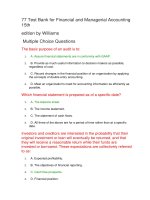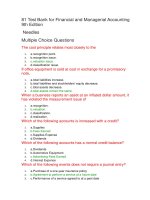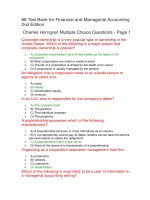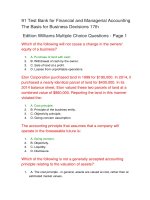142 test bank for financial and managerial accounting 3rd edition
Bạn đang xem bản rút gọn của tài liệu. Xem và tải ngay bản đầy đủ của tài liệu tại đây (186.91 KB, 42 trang )
142 Test Bank for Financial and Managerial Accounting
3rd Edition
True-False Questions
In an LLC, the business-not the owners-are responsible for the corporation's
debts.
1.
True
2.
False
Board members of a not-for-profit organization have fiduciary responsibilities
that constitute legal obligations to manage the organization in a trustworthy
manner.
1.
True
2.
False
Stockholders of a corporation each have "mutual agency," meaning they are
authorized to carry out transactions on behalf of the corporation.
1.
True
2.
False
Similar to partnerships, in a limited-liability company (LLC., the members are
personally liable for the debts and obligations of the business.
1.
True
2.
False
A business owner starts a new business and invests $6,000 in exchange for
shares of stock. This transaction results in an increase in the corporation's
liabilities.
1.
True
2.
False
IFRS (international accounting rules. are much more specific than GAAP and
allow for far less professional judgment.
1.
True
2.
False
The balance sheet of a corporation represents the account balances as of a
particular date in time.
1.
True
2.
False
There are four major forms of business organizations.
1.
True
2.
False
Independent accountants that audit public companies come under the
regulatory supervision of the PCAOB.
1.
True
2.
False
The PCAOB is a watchdog agency that monitors the work of small, privately
owned businesses.
1.
True
2.
False
A not-for-profit organization has owners just like other forms of business.
1.
True
2.
False
Accounting is "the language of business."
1.
True
2.
False
The balance sheet shows whether or not a company is earning profits.
1.
True
2.
False
Outside investors would ordinarily use financial accounting information to
decide whether or not to invest in a business.
1.
True
2.
False
Business owners use accounting information to set goals, evaluate progress
toward those goals, and take corrective action when needed.
1.
True
2.
False
IFRS are the international accounting rules that U.S. companies must follow
for their international operations.
1.
True
2.
False
Many liabilities have the word "receivable" in their titles.
1.
True
2.
False
The faithful representation principle requires that information is complete,
neutral and free from material error.
1.
True
2.
False
A creditor is a party that has an ownership interest in a business.
1.
True
2.
False
GAAP is the set of accounting rules for international accounting.
1.
True
2.
False
The most an investor in a corporation can lose-in the event the business failsis limited to the amount the party has invested.
1.
True
2.
False
By looking at a statement of retained earnings, you can evaluate the effect
that paying dividends has on the ending balance in stockholders' equity.
1.
True
2.
False
Different users of the financial statements (investors, creditors, tax
authorities, etc.. all focus on the same parts of the financial statements for the
information they need.
1.
True
2.
False
The income statement shows whether or not a company can generate enough
cash to pay its liabilities.
1.
True
2.
False
The AICPA's Code of Professional Conduct for Accountants provides
guidance to CPAs in the performance of their work.
1.
True
2.
False
Corporations are subject to stricter regulation than other forms of businesses,
so it is more difficult for corporations to raise large amounts of investment
capital.
1.
True
2.
False
The relative proportion of economic resources and obligations would be
shown by the balance sheet.
1.
True
2.
False
Managerial accounting focuses on information for decision makers outside
the company, such as creditors and taxing authorities.
1.
True
2.
False
An investor is someone who loans money to a business.
1.
True
2.
False
Accounting is the information system that measures business activity,
processes the data into reports, and communicates the results to decision
makers.
1.
True
2.
False
A U.S. publicly traded company does not come under SEC regulations as long
as it follows the rules of GAAP.
1.
True
2.
False
IFRS accounting rules apply to all U.S. corporations.
1.
True
2.
False
Multiple Choice Questions-Page 1
The separation between the owners and the managers of a business is most
distinct in a(n.:
1.
A. corporation.
2.
B. LLP.
3.
C. partnership.
4.
D. proprietorship.
The Sarbanes-Oxley Act ("SOX". made it a criminal offense to:
1.
A. steal shareholders' money.
2.
B. default on loans from creditors.
3.
C. declare bankruptcy.
4.
D. falsify financial information.
Caleb Brown has been the sole owner of a bicycle sales and repair shop for
many years. Which of the following business types would best protect Caleb's
personal assets from product liability exposure?
1.
A. Partnership
2.
B. Limited liability company
3.
C. Proprietorship
4.
D. Not-for-profit
Accounting standards are formulated by the:
1.
A. SEC.
2.
B. AICPA.
3.
C. FASB.
4.
D. IRS.
Which of the following is a licensed accountant who serves the general public
rather than an accountant who serves one particular company?
1.
A. CPA
2.
B. CMA
3.
C. SEC
4.
D. FASB
Phillip and Reed have developed a new technology for home computer
systems. However, they need to raise a large amount of capital to build the
production and support facilities to market their product successfully. Which
of the following business types would be best suited to help the company
raise the necessary capital to begin production?
1.
A. Corporation
2.
B. Proprietorship
3.
C. Partnership
4.
D. Limited liability partnership
Which of the following statements BEST defines financial statements?
1.
A. Financial statements are the information system that records and measures
business transactions.
2.
B. Financial statements are the verbal statements made to business news
organizations by chief financial officers.
3.
C. Financial statements are documents that report on a business in monetary terms,
providing information to help people make informed business decisions.
4.
D. Financial statements are plans and forecasts for future time periods.
A promise received from a company's customers to pay for goods and
services that they received from the company is called a(n.:
1.
A. account receivable.
2.
B. account payable.
3.
C. revenue.
4.
D. expense.
Which of the following statements BEST describes managerial accounting?
1.
A. Managerial accounting focuses on information for internal decision making.
2.
B. Managerial accounting focuses on outside investors and lenders.
3.
C. Managerial accounting provides information for the public.
4.
D. Managerial accounting provides information for taxing authorities.
There are relatively few types of revenue. Which of the following in NOT a type
of revenue?
1.
A. Common Stock
2.
B. Service
3.
C. Interest
4.
D. Sales
If a corporation cannot pay its debts, the creditors may make claims against
the:
1.
A. assets of the shareholders.
2.
B. assets of the company only.
3.
C. assets of the board of directors.
4.
D. employees of the company.
Lindsey Smith decided to start her own CPA practice as a professional
corporation, Smith CPA PC. Her corporation purchased an office building for
$35,000 which her real estate agent said was worth $50,000 in the current
market. The corporation records the building as a $50,000 asset because
Lindsey believes that is the real value of the building. Which of the following
concepts or principles of accounting is being violated?
1.
A. Cost principle
2.
B. Entity concept
3.
C. Stable monetary unit concept
4.
D. Going-concern concept
The ability to raise large amounts of capital is a key characteristic of a:
1.
A. partnership.
2.
B. not-for-profit.
3.
C. corporation.
4.
D. proprietorship.
Many organizations have contributed to the establishment of generally
accepted accounting principles. Which of the following organizations has the
primary responsibility for formulating accounting standards?
1.
A. FASB
2.
B. CMA
3.
C. AICPA
4.
D. SEC
The first step in incorporation is to:
1.
A. have the board of directors designate a president.
2.
B. agree to a set of bylaws.
3.
C. issue the first shares of stock.
4.
D. obtain a charter from the state.
Which of the following is NOT a characteristic of a traditional partnership?
1.
A. A partnership is owned by shareholders or stockholders.
2.
B. If a partnership cannot pay its debts, lenders can take the owners' personal assets
to satisfy the obligations.
3.
C. A partnership joins two or more individuals as co-owners.
4.
D. Each partner has the authority to commit the entire partnership to a binding contract.
By definition, which of the following represent the owners of a corporation?
1.
A. Customers
2.
B. Creditors
3.
C. Stockholders
4.
D. Employees
The owner(s. of a business will most likely face "double taxation" if their
business is organized as a(n.:
1.
A. corporation.
2.
B. LLC.
3.
C. partnership.
4.
D. proprietorship.
Which of the following concepts (principles. require an assumption that the
entity will remain in operation for the foreseeable future?
1.
A. Entity concept
2.
B. Faithful representation principle
3.
C. Going-concern concept
4.
D. Cost principle
A corporation has all of the following EXCEPT:
1.
A. a state charter.
2.
B. a board of directors.
3.
C. unlimited liability for shareholders.
4.
D. shares of stock.
The largest businesses are usually organized as:
1.
A. corporations.
2.
B. partnerships.
3.
C. proprietorships.
4.
D. LLCs.
Tate Corporation purchased a building for its grocery store for $30,000 in
1970. Based on inflation estimates, the amount of this asset has been
adjusted in the accounting records. The building is now reported at $75,000.
Which of the following concepts or principles of accounting is being
violated?
1.
A. Going-concern concept
2.
B. Stable monetary unit concept
3.
C. Entity concept
4.
D. None of the above
Which of the following organizations or groups issue an opinion on whether a
company's financial statements are a fair representation of the company's
financial situation?
1.
A. SEC
2.
B. Board of Directors
3.
C. Shareholders
4.
D. Independent Accountants (CPAs.
Which of the following are likely to be users of financial accounting
information?
1.
A. Taxing authorities
2.
B. Creditors
3.
C. Potential investors
4.
D. All of the above
The Ragun Cajun Bar and Grill, Inc. has been a popular restaurant in
Beaumont, Texas. With no insurance, a recent hurricane has left the business
with large losses due to a damaged building and lost business income. Which
of the following concepts or principles of accounting will be of the greatest
concern to Ragun Cajun's auditors?
1.
A. Going-concern concept
2.
B. Faithful representation principle
3.
C. Entity concept
4.
D. Stable monetary unit concept
Stockholders' equity is $150,000 and total liabilities are $90,000. Total assets
would be:
1.
A. $300,000.
2.
B. $180,000.
3.
C. $60,000.
4.
D. $240,000.
The primary objective of financial reporting is to provide information useful
for making investment and lending decisions. Which of the following is NOT
one of the basic characteristics that financial information must possess to be
useful?
1.
A. Reliability
2.
B. Creativity
3.
C. Relevance
4.
D. Comparability
A corporation possesses all but one of the following characteristics. Which of
the following is NOT a characteristic of a corporation?
1.
A. If a corporation cannot pay its debts, lenders can take the owners' personal assets
to satisfy the obligations.
2.
B. A corporation is a distinct entity in the eyes of the law.
3.
C. Corporation ownership is divided into shares of stock.
4.
D. A corporation is owned by shareholders or stockholders.
Accountants often refer to GAAP. What do the letters GAAP represent in
accounting?
1.
A. Globally accepted and accurate policies
2.
B. Global accommodation accounting principles
3.
C. Generally accredited accounting policies
4.
D. Generally accepted accounting principles
Which of the following are MOST likely to be users of managerial accounting
information?
1.
A. Potential investors
2.
B. Creditors
3.
C. Customers
4.
D. Company managers.
A corporation is a legal entity entirely distinct from its:
1.
A. proprietors.
2.
B. vendors.
3.
C. customers.
4.
D. stockholders.
In an LLC, who is responsible for the company's debts?
1.
A. The company itself
2.
B. The partners
3.
C. The individual investors
4.
D. The proprietor
Items such as buildings and land are:
1.
A. liabilities.
2.
B. equity.
3.
C. assets.
4.
D. revenues.
Which of the following is a characteristic of a limited liability partnership
(LLP.?
1.
A. A limited liability partnership issues shares of stock to shareholders.
2.
B. Each partner is liable only for the actions under his or her control.
3.
C. A limited liability partnership is owned by a single investor.
4.
D. The limited liability partners are subject to "double taxation."
Businesses can be organized in a variety of forms. The types of businesses
commonly found in the U.S. include all of the following EXCEPT:
1.
A. corporations.
2.
B. state government-run companies.
3.
C. partnerships.
4.
D. proprietorships.
Dylan Chase is a partner in a CPA practice. One of Dylan's partners
sometimes takes a very aggressive position when auditing clients. Which of
the following business types would protect Dylan's personal assets from
malpractice liability for his partner's aggressive auditing tactics?
1.
A. Limited liability partnership
2.
B. Traditional partnership
3.
C. Not-for-profit
4.
D. Proprietorship
Corporate ownership is a very popular type of ownership in the United States
because:
1.
A. corporate shareholders have limited liability for the debts of the corporation.
2.
B. most corporations are small or medium-sized companies.
3.
C. the life of a corporation is limited by the death of an owner.
4.
D. a corporation is usually managed by the owners.
Bill Rogers has three different businesses. He has only one bank account for
transactions relating to all his various businesses. Which of the following
concepts or principles of accounting is Bill violating?
1.
A. Faithful representation principle
2.
B. Entity concept
3.
C. Cost principle
4.
D. Going-concern concept
A financial examination of a company's financial records is called a(n.:
1.
A. audit.
2.
B. criminal investigation.
3.
C. financial analysis.
4.
D. appraisal.
Which of the following organizations requires publicly owned companies to
be audited by independent accountants (CPAs.?
1.
A. SEC
2.
B. PCAOB
3.
C. FASB
4.
D. AICPA
David has decided to open an auto-detailing business. He will pick up an
automobile from the client, take it to his parents' garage, detail it, and return it
to the client. If he does all of the work himself and takes no legal steps to form
a special organization, which type of business organization, in effect, has he
chosen?
1.
A. Limited liability company
2.
B. Partnership
3.
C. Corporation
4.
D. Proprietorship
Which of the following is TRUE for a proprietorship?
1.
A. A proprietorship joins two or more individuals as co-owners.
2.
B. The proprietor is not personally liable for the debts of the proprietorship.
3.
C. A proprietorship has a single owner.
4.
D. A proprietorship has an indefinite life.
A debt that a corporation owes to an outside party is called:
1.
A. an asset.
2.
B. a liability.
3.
C. stockholders' equity.
4.
D. revenue.
Which of the following is the CORRECT accounting equation?
1.
A. Assets + Liabilities = Stockholders' equity
2.
B. Assets = Liabilities + Stockholders' equity
3.
C. Assets + Revenue = Stockholders' equity
4.
D. Assets + Revenue = Liabilities + Expenses
110 Free Test Bank for Financial and Managerial
Accounting 3rd Edition by Horngren Multiple Choice
Questions-Page 2
A $5,000 account payable is paid by the company. How is the accounting
equation affected?
1.
A. Assets decrease $5,000; stockholders' equity increases $5,000.
2.
B. Assets decrease $5,000; liabilities decrease $5,000.
3.
C. Assets increase $5,000; stockholders' equity decreases $5,000.
4.
D. Assets increase $5,000; liabilities increase $5,000.
Martin Supply Co. received $1,000 cash from a customer which was owed to
the company from the previous month. Which of the following accounts
decreases?
1.
A. Cash
2.
B. Retained earnings
3.
C. Accounts payable
4.
D. Accounts receivable
Joe purchased office equipment for $1,250 cash. What is the effect on
accounts?
1.
A. One asset account increases; one liability account increases.
2.
B. Two asset accounts increase.
3.
C. One asset account increases; another asset account decreases.
4.
D. One asset account increases; one equity account increases.
Hamilton Service Co. incurred a $500 labor expense and promised to pay the
labor agency within 30 days. Which account increased?
1.
A. Accounts receivable
2.
B. Cash
3.
C. Accounts payable
4.
D. Retained earnings
Hamilton Service Company earned $1,000 for services rendered. The
customer promised to pay at a later time. Which of the following accounts
increased?
1.
A. Accounts payable
2.
B. Common stock
3.
C. Cash
4.
D. Accounts receivable
Martin Supply Co. received $1,000 cash from a customer which was owed to
the company from the previous month. What is the effect of the cash receipt
on the accounts of the company?
1.
A. Accounts receivable decreases; Retained earnings account decreases.
2.
B. Cash account increases; Accounts receivable decreases.
3.
C. Accounts payable increases; Retained earnings account decreases.
4.
D. Cash increases; Accounts payable decreases.
The assets and liabilities of Matt Wesley Corporation are as follows: Cash,
$10,000; Accounts receivable, $8,200; Supplies, $1,050; Land, $25,000;
Accounts payable, $6,530. What is the amount of stockholders' equity?
1.
A. $21,500
2.
B. $44,430
3.
C. $50,780
4.
D. $37,720
Martin Supply Co. paid $350 cash to a materials supplier that it owed from the
previous month. Which of the following accounts decreases?
1.
A. Accounts receivable
2.
B. Accounts payable
3.
C. Retained earnings
4.
D. Common stock
The business collects a $5,000 account receivable from its customer. How is
the accounting equation affected?
1.
A. Assets increase $5,000; liabilities decrease $5,000.
2.
B. One asset increases by $5,000; another asset decreases $5,000.
3.
C. Assets increase $5,000; liabilities increase $5,000.
4.
D. Assets increase $5,000; stockholders' equity increases $5,000.
Assets are $270,000 and stockholders' equity is $90,000. Liabilities will be:
1.
A. $60,000.
2.
B. $360,000.
3.
C. $270,000.
4.
D. $180,000.
Assets are $150,000 and total liabilities are $90,000. Total stockholders' equity
will be:
1.
A. $180,000.
2.
B. $300,000.
3.
C. $240,000.
4.
D. $60,000.
The owners' claims to the assets of the business are called:
1.
A. revenues.
2.
B. liabilities.
3.
C. owners' equity.
4.
D. expenses.
Tim invests money into his business in exchange for stock. The two accounts
affected are:
1.
A. an asset and a liability.
2.
B. an asset and an equity.
3.
C. a liability and an equity.
4.
D. two asset accounts.









